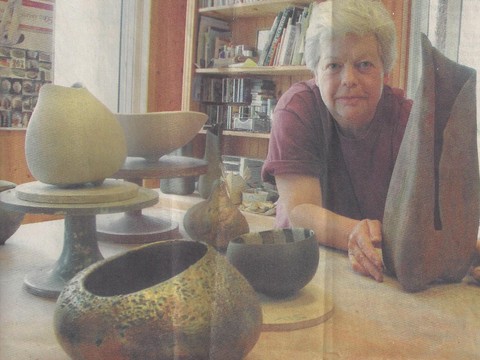Keefe Janet
Article by Kathleen Hay
Standard-Freeholder
May 16, 2007
Every curve and crevice of Janet Keefe's raku pottery captures a moment in time and art. The award-winning Williamstown area potter showcased her "Painter Potter Painter" at the Abbey for the Arts, in Glen Nevis.
It is difficult to fathom Janet Keefe flunking pottery. Well it wasn't actually pottery the award winning artisan failed, it was her dogged focus only on the clay that was her demise. "I remember having to draw a shrimp as homework " she says, scrunching up her eyebrows as she recalls her studies at the Epsom College of Art and Design, in England. "I wanted to do a degree in pottery; but failed, which was probably a good thing at the time. '' 1 was supposed to be proficient in all areas, but I just wanted to play with pottery." And that she has.
An award-winning potter, whose work has been shown from Cornwall to Ottawa and Windsor. Keefe has had a long-time love affair with pottery. Now a member of Montreal's farfelu gallery she was introduced to visual arts in high school and felt immediately at home working in three dimensions. After her two years at Epsom and a year in Paris, studying pottery, drawing and sculpture in private studios, she decided to change direction to train and work as an occupational therapist.
In retrospect, she feels, the life experience she now brings to her designs couldn't have been found only in a classroom. Immigration to Canada with her husband and young family in 1982, a long time career as a therapist, not to mention everyday life, all bring their own elements to each and every work of sculpture she molds with her hands.
Although she studied wheel-thrown functional, Keefe's preferred method of pot construction is coiling. Sitting at her studio table, she painstakingly rolls out sometimes shorter, sometimes much longer, coils of clay. One layer at a time, she secures them to a base using slip, letting each dry just enough to support the next. As each layer is added, joins are smoothed, or refined. The contour, or profile, is again refined once the pot is complete, then it's dried completely before biscuit-firing. It's a labour intensive process, each step filled with thought and a love for the art.
Biscuit-firing fuses the clay particles. On average, a 12-inch pot can take upwards of 14hours of firing. Then it's cooled and glazed, then fired again in her outdoor raku kiln, heated with an intense propane flame until temperatures reach around 900 degrees Celsius.
It's a two-person job to do effectively and she relies upon Ray Target, another raku enthusiast and potter, to help her with the firing process. The propane turned off, Target lifts the cumbersome lid off the kiln, while Keefe is at the ready.
"Stand back," she warns, as she picks up the blistering hot pieces with what appears to be over-sized salad tongs, then turns to deposit it in a bin lined with hay. The pottery is engulfed in fire when it hits the dry hay, its strands embedding their own unique marks on the piece. Keefe rapidly covers the bin with a lid, sometimes lifting it quickly to add a little air.
Sitting back, the piece now safely cooling in the bin to develop the metallic lustres of the glaze, she explains further, removing heavy gloves covering her hands.
"You don't kiln without great care," she notes. "You wear leather shoes and all your skin is covered. "Wear cotton, too, not nylon. I heard once of a woman who wore a synthetic bra, and it got stuck to her." Ouch.
For raku potters like Keefe and Target, the excitement really begins when the cooled piece is removed from its now blackened bed of hay. When you make your own glazes, as they do, it's much like Christmas when you revel in the metallic lustres of the glazes.
Beautiful golds, rich reds, burnished coppers "gleam. Turning each piece slowly, they marvel at the sculptures. Sensuous and swelling forms, echo the shapes of growth and decay, as it flows inside and out.
Finally, each piece is washed, allowed to dry and the bare, blackened area's are waxed and polished. The process is complete. "I just love clay, there's something special about it. If you could explain it, you wouldn't need to do it. Sometimes you need to feel, rather than think," Keefe says.
- Californium
- Diamond
- Gold
- Silver
